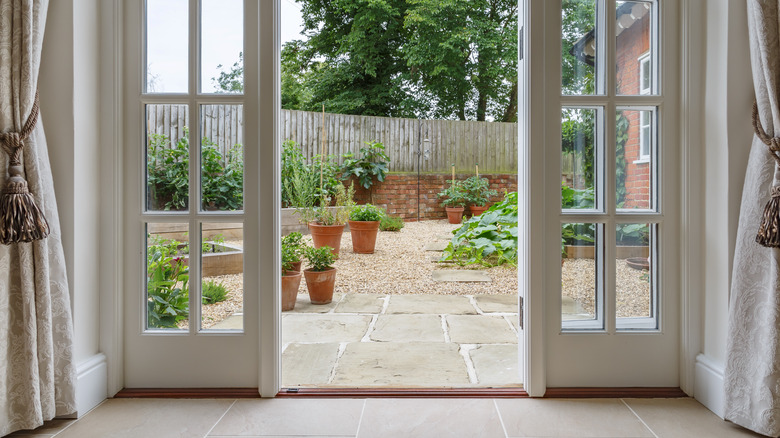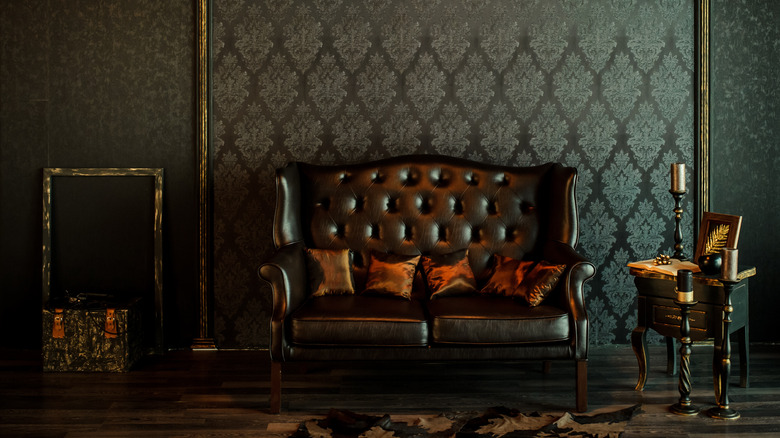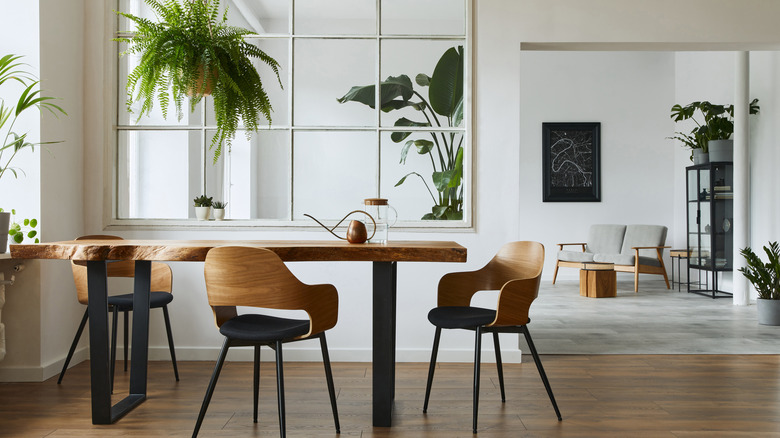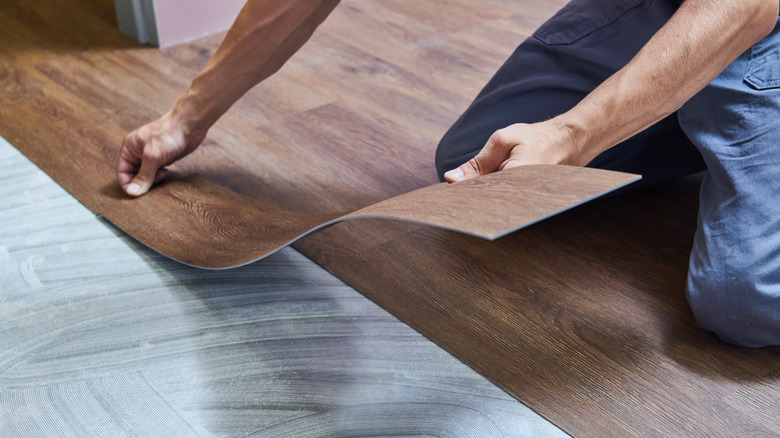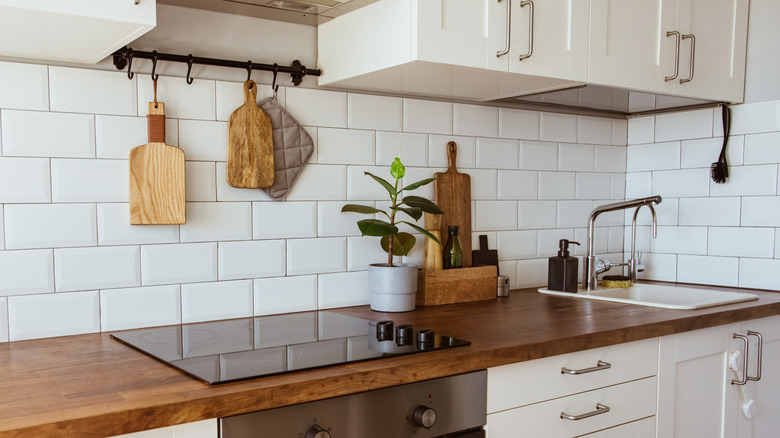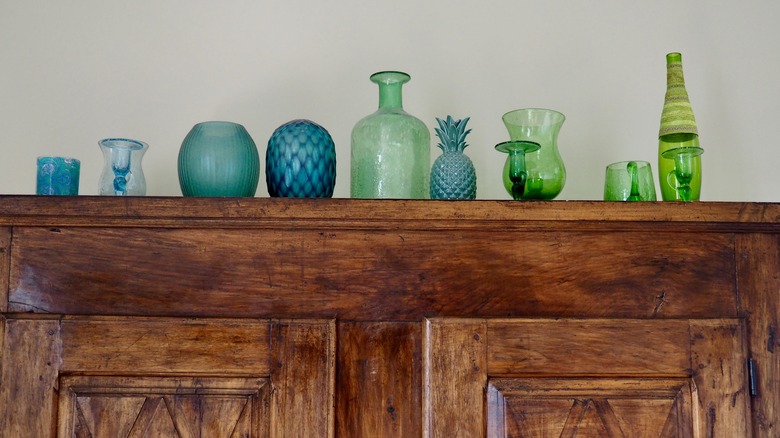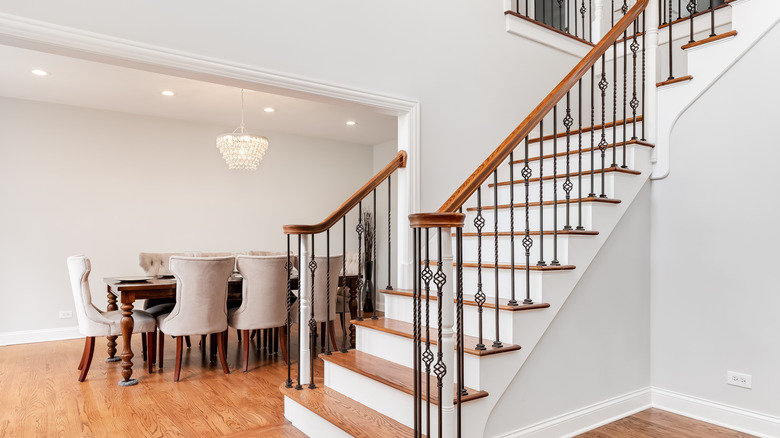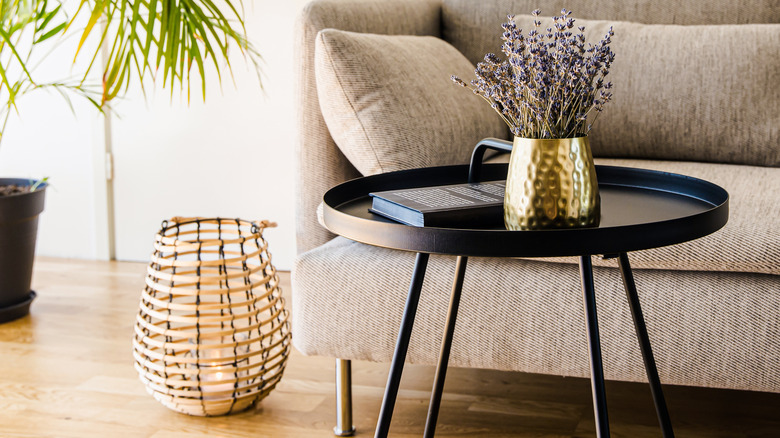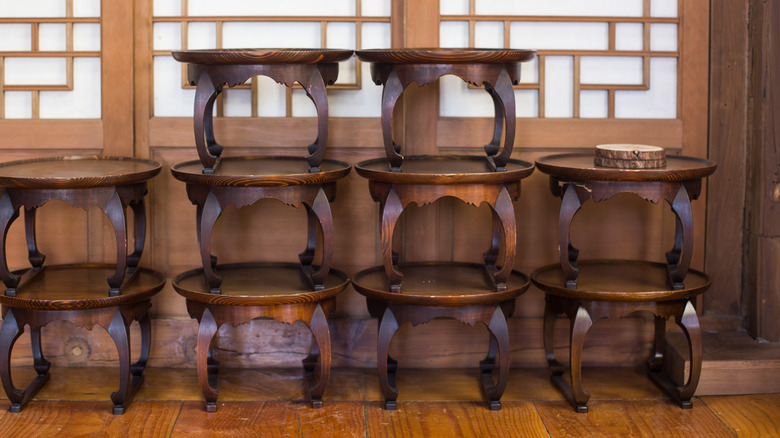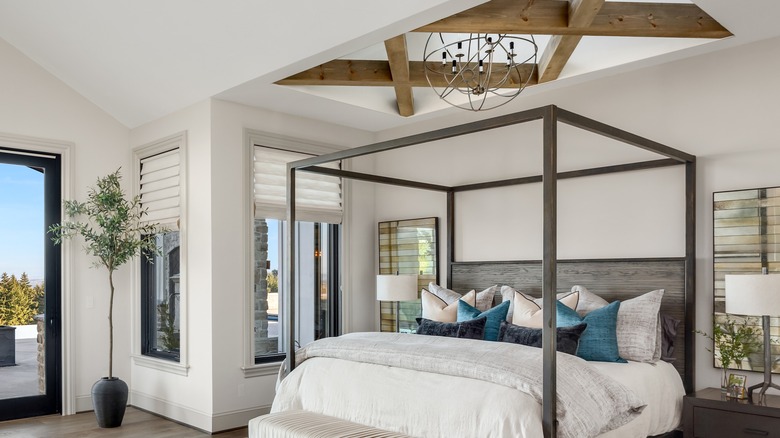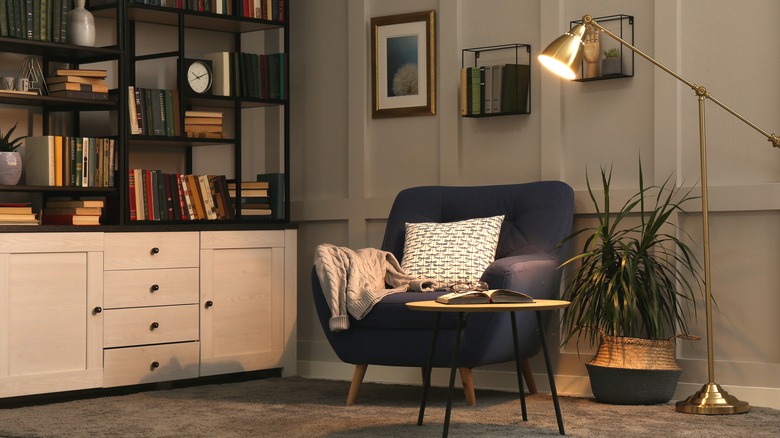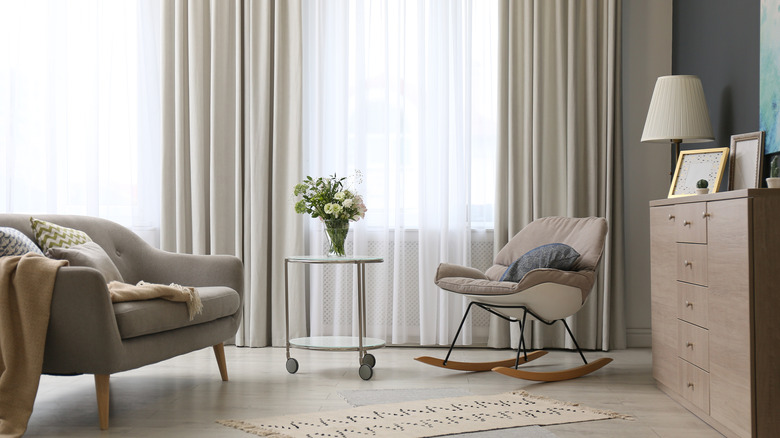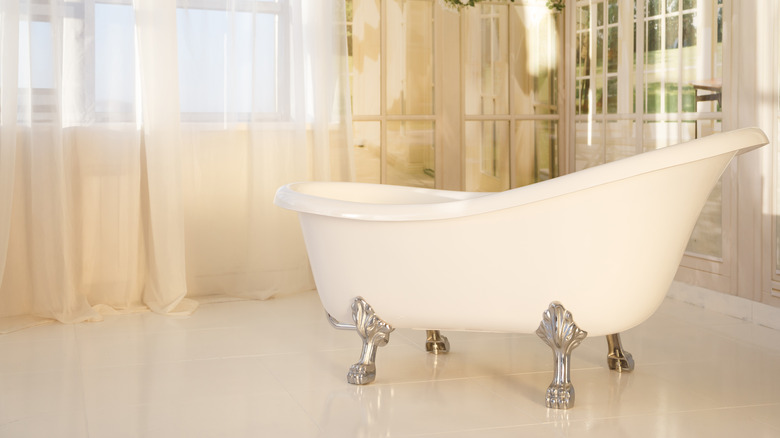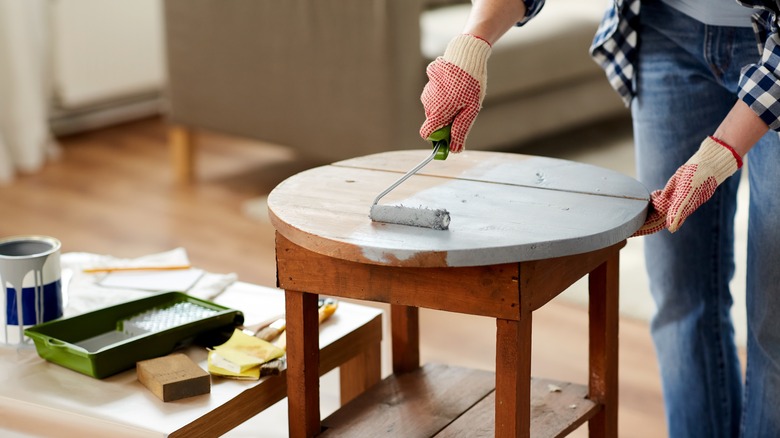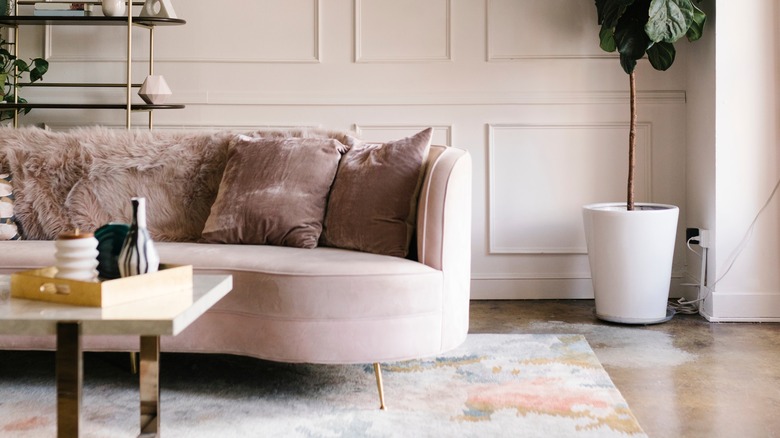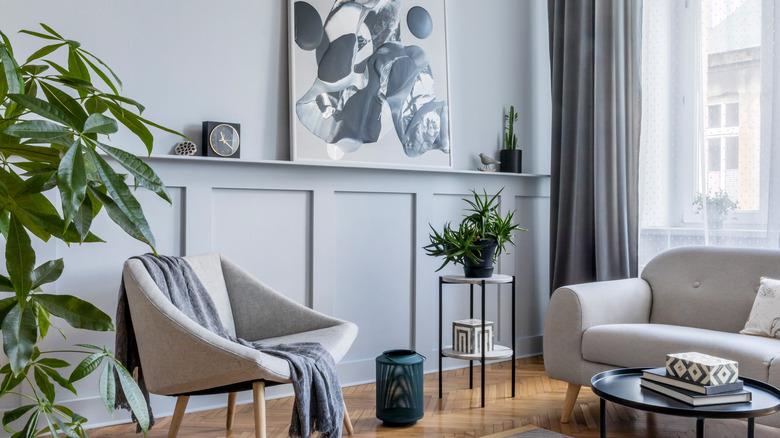The Ultimate Guide To French Provincial Decor
With the resurgence in popularity of coastal and cottagecore, another interior trend is making its way back into the spotlight: French provincial. According to Kate & Laurel, French provincial is a decor trend that gained popularity during the 1600s in Normandy, Provence, and Brittany. The design took its inspiration from the grand beauty of Versailles architecture and centered around bringing wealthy glamor to non-aristocratic members of society. According to House Beautiful, the trend made its way to America after WWI during the 1920s and again during the 1960s when soldiers started taking inspiration from the elegant style and requesting french ranch style homes.
Commonly misidentified as French country, French provincial focuses a bit more on luxury while French country focuses on rustic appeal. However, these two trends work together in modern-day interior design to bring a cozy, hygge-inspired dimension into homes (via My Chic Obsession). This interior style is the perfect blend of costal minimalism and French regency, making it glamorous without having a maximal feel.
Play with rustic woods
A common theme found in both French country and French provincial is using wood in your home, especially with furniture. According to Home Questions Answered, French provincial furniture was often made from apple, beech, pear, peach, and oak wood because they were affordable and easy to obtain in French provinces. Drawing inspiration from the French regency, furniture pieces often had carvings or fabric embroidery that showcased landscapes and mythological scenes.
According to Better Homes and Gardens, a great way to decorate with vintage wood furniture is to repurpose it for more modern use. This can include using a wooden dresser as wine storage or an armoire to hold linens in a hallway. Another way to incorporate wood into your home is to mix wood in various tones. Many people are intimidated when decorating with vintage wood because every piece is aged and seems to have different undertones. As a general rule of thumb, wood pieces can be mixed as long as the dominant undertone is showcased in the room in another way. For example, if you're decorating with mixed furniture, but most have a yellow undertone, focus on using fabrics or linens in the room that are on the warmer side.
Use neutral tones
One of the reasons French provincial is gaining popularity is because it uses a very muted and zen-inspired color palette. Rather than using bright jewel tones associated with glam interiors, Brocante Ma Jolie suggests French country and provincial should favor natural and neutral colors. Designers still favor these colors hundreds of years later because they're so timeless and inviting. Additionally, these specific neutral colors match with virtually any interior, allowing clients to customize their home as many times as they want without having to repaint or repurchase pieces.
The French provincial color scheme includes a few different palettes. The first focuses on complementing items that can't easily be changed, such as flooring. This includes ivory white or ecru, cream, beige, linen, gray, taupe, and black. These colors make a space appear brighter or more toned down, making decorating easier. For accents, faded colors like light green, ochers, French blue, mauve pink, and lavender are used. These colors are typically painted using chalk-like finishes or found in faded and dusty linens. The general rule in French decor is warm colors remind you of warm places and make large rooms cozier, while cool colors remind us of the outdoors, making small rooms larger and more relaxing.
Install parquetry flooring
A favorite throughout French architecture is parquetry flooring. Parquetry flooring is a geometric mosaic of wood used in decorating, commonly on flooring. According to Wood and Beyond, this flooring style was popular in the mid-1600s and featured squares, triangles, and lozenges using blocks of wood. Traditionally, patterns featured stars or mosaics of sunshine, but today it's commonly used to create herringbone patterns. For parquetry, contrasting woods are mixed together to enhance the design and are glued down using a cold adhesive.
According to The Spruce, parquetry wood flooring costs on average $20 to $45 a square foot to install. However, there are peel and stick options available that make the trend affordable and easy to maintain. If you choose to use peel and stick flooring, it's important to remember that cleaning can be more difficult with this material because it's held on by pressure and glue, which is vulnerable to warping and cracking.
Have a statement kitchen
One of the most notable features in French decor is a statement kitchen that the home centers around. According to House Beautiful, French provincial kitchens commonly have limewashed cabinetry and paneling, giving the wood a soft white cast and creating an elegant atmosphere. This trend is easy for any level DIYer to take on. Simply create a limewash and brush it onto your prepped cabinets (via Real Homes). Limewashing maintains the look of natural wood and gives it an extra level of protection and color. Some washes also come with pigment which brings out the natural grain in your wood.
French decor also features whimsical embellishments to showcase the architecture. This can be achieved by painting a mural on your walls of scrolls or gradient art, or applying a peel and stick wallpaper that features French-inspired designs. According to Better Homes and Gardens, French provincial kitchens also feature matte and neutral based colors, which help create a bright space. It's also common to see natural stone used as backsplashes in these kitchens. Designers favor granite and marble because they're so timeless, but popular white subway tiles can also create a complete look.
Decorate with armoires
A classic staple in French decor is the armoire. According to Chairish, traditionally, an armoire is a large cupboard usually used to organize clothing and linens or store weapons and armor, hence its name. Nowadays, armoires are ornate pieces of furniture that can be modified to be entertainment centers, cupboards, storage, and closets.
If you want to incorporate an armoire into your home, there are so many options to make this large piece of furniture functional and aesthetically pleasing. According to ConfettiStyle, an armoire can be used to create a vignette and showcase art, baskets, or memorable family heirlooms. Additionally, you can remove the doors of an armoire to make a bookshelf that has regency flair. Armoires can also be retrofitted to showcase crystal and dishes in a dining area or kitchen (via Houzz). They're also a great way to provide visual interest in a space that does not have a fireplace or a built-in fixture point. They were designed to be customizable and to come apart, so you should have no issue customizing even the oldest armoire to fit your current needs.
Incorporate wrought iron accents
Wrought iron is an interior designer favorite and a staple of French designs. According to Timeless Wrought Iron, wrought iron itself comes in two types of iron — charcoal and puddle. The kind of iron depends on the period the piece was made. Charcoal iron was popular toward the end of the 18th century, while puddle iron was common during the industrial era. Initially, wrought iron became popular in the 18th and 19th centuries despite existing since ancient Egypt because it blended masculinity with classical minimalism (via L'Essenziale). Because wrought iron was easily accessible in the provinces and offered the luxurious feel people wanted, it quickly grew in popularity.
A great way to bring wrought iron into your home and create a French provincial style is to use wrought iron cabinet hardware and doorknobs (via SFGate). You can also use wrought iron in tables to showcase glass or wood surfaces or in French-style bistro outdoor tables.
Use gold accents throughout the space
A common theme in French provincial design is using polished metallic accents, usually gold or brass. According to The Spruce, a great way to add gold accents into your home is to upgrade your exposed plumbing with gold pipes or spray painting the pipes and hardware you already have. You're also able to add little details like a gold handle on the toilet or a gold trash can to work in gilded accents without being overly glam. If you wanted to add gold details to a common area without entering art deco or regency territory, you can also spraypaint bookends to be a muted shade of gold, add gold tape or leaf onto a vase, or work in gold accents in the kitchen in the form of bar stools or cabinet hardware.
If you choose to spraypaint existing pieces gold, Bob Vila suggests being careful when picking shades. A lot of people run into the problem of their gold spraypaint drying bronze, and while this does fit into French provincial, it may not be the look you're personally going for. If you're looking for true gold, pick a spraypaint that markets itself as pure or vintage gold, not one with a red or orange tint.
Look for cabriole legs
The Spruce defines cabriole legs, or bowlegs, as a furniture leg with its top curving outward while its bottom curves inward, creating an ornamental footed design. The cabriole leg is commonly fashioned with a ball on the end or a claw-style foot. Cabriole legs gained popularity in Europe in the 18th century, especially in France and England (via British Antique Dealers' Association). In the U.S., the most common design is referred to as Queen Anne Style and is seen in virtually almost all furniture from that period of history. Queen Anne furniture has cabriole legs that are thinner on the ankle and have a pad-style foot (via SFGate). There is also Chippendale Style, which was named after the furniture designer Thomas Chippendale, who made the signature shape famous. Chippendale style is similar to Queen Anne, but usually has a ball and claw foot and is larger in scale. Additionally, Louis XV style legs are shorter versions of the Queen Anne style and have intricate details and carvings, making them perfect for French provincial rooms.
While many vintage and modern pieces have a cabriole-inspired design, it's also easy to make or purchase cabriole legs for your existing pieces. According to John Malecki, anyone can make cabriole legs — all they need is a template and a bandsaw.
Install exposed beams
A common feature in French provincial and French country homes is exposed or overhead beams. According to Bob Vila, overhead beams were a standard element in construction that featured wood framing because it was functional. The larger beams helped support the weight of upper floors and made contracting easier. Because of this, exposed beams started appearing in cottages and castles in Europe, becoming a staple in their designs. In the 1800s, exposed beams were made smaller and more aesthetically pleasing due to advances in construction.
Nowadays, this style of framing isn't as common, and exposed beams are seen as an aesthetic choice over a structural one. Installing wood beams can cost upwards of $22 to $30 per linear foot (via Homewyse). Luckily, you can fake the look of wood beams without having to install actual wood. According to This Old House, high-density polyurethane is used to make faux beams that are lightweight and easy to install. You can also make affordable fake wood beams yourself by using plywood or common board and fashioning it into a U-shape (via Simply Aligned Homes).
Decorate with antique furniture
A common staple of French provincial decor is using vintage pieces in your space. This could be a vintage interior door, vintage shutters, or a secondhand armoire that is converted to fit your needs. A popular style of furniture associated with modern French provincial decor is the Queen Anne style. According to Aaron's Touch Ups, the Queen Anne style was originally produced between the 1720s and 1750s, but wasn't mass produced in the United States until 1800. These furniture pieces were popularly made with walnut, cherry, or maple, but around the 18th-century, pieces were made using mahogany. Collectors warn that if a piece uses wood like pine, ash, beech, or cedar, the item may not be entirely original or a knock-off produced at a later date.
According to Veranda, decorating with vintage pieces does not have to be intimidating or overly trendy. A great way to work in vintage pieces is to find something you're emotionally attached to, even if it doesn't match the style of your home. It's also recommended that vintage pieces be statement pieces, like an old table or light fixture. Vintage furniture can also be repurposed or restored to match the style of your home. Wood can be stained, pieces can have their legs or doors cut off, and can be reused as a bookshelf, closet, desk, or end tables.
Install window dressings
According to Stoneside, French country and provincial use chateau-inspired window treatments. These window treatments are known for proportioned shades or drapes inspired by nature, making them a staple of elegance amongst interior designers and decor lovers. Nowadays, this look can be adapted to any home — French countryside or not — by using roman shades. Roman shades are an alternative to blinds using fabric instead of plastic, making them feel tailored and custom. In a provincial-style home, it's recommended that colors are kept natural. Most custom drapes are hung higher than the window, making the room appear more voluminous. Additionally, simple sheers are mixed with heavy fabrics to create a luxurious layered look.
Because French provincial was about displaying wealth, you could also decorate windows using luxurious fabrics, like silk or satin. When picking sheers or textured drapes, choose oversized window coverings that cascade onto the floor. This allows for the appearance of a larger window while still remaining glamorous and luxurious feeling.
Farmhouse vs. provincial vs. chateau
It's easy to get popular French design styles confused with each other. After all, French farmhouse, provincial, and chateau share many similarities and can be adapted into virtually any decor to create an elegant atmosphere. According to Brocante Ma Jolie, the biggest difference between French farmhouse and provincial is the subtle details. French farmhouse focuses on rustic elements, like distressed woods and warm tones, while provincial focuses on bringing out elegant elements despite having rustic and warm decor. Instead of distressed furniture, you'll find gold Georgian mirrors, console tables with iron, or quaint cupboards with scrolling details engraved or varnished into the wood.
On the other hand, chateau differs from the other two in terms of stylistic direction. While it can be incorporated into a farmhouse or rustic home, chateau decor focuses primarily on neoclassical elements. Instead of playing with distressed woods, French chateau was about showing off wealth and ornate pieces. This design uniquely focused on large-scale furniture and accent pieces that looked of high quality and had a high level of detail. This is because decoration during the height of chateau decor was about showcasing social rank, similar to Hollywood Regency in America a few decades later. Homes of wealthy individuals were lined with intricate wall moldings, marble fireplaces, and oversized items like beds or clawfoot tubs.
Milk paint your furniture
Throughout classic French decor, there's one element commonly found: white or milk painted furniture. According to This Old House, milk paint is a paint formulated from casein, a protein found in milk. It also uses lime, pigment, and borax. Nowadays, many people are choosing milk paint over traditional stain or acrylic paint for its matte antique finish. Based on the application method, milk paint can offer a polished look or be distressed to achieve a chippy finish, which compliments rooms that are looking to add French rustic flair.
Painting with milk paint is a great way to add color into the muted French provincial palette and refurbish old furniture that may not go with your overall design. If you choose to paint a furniture piece with milk paint, be sure to sand the piece lightly and lightly buff it before painting, which allows the paint to adhere better and ensures it will last for many years. According to My Painted Door, to achieve a slightly chipped finish on your milk paint project, before painting, use a little beeswax on areas where you want the paint to naturally wear off. The wax will prevent the color from penetrating fully, leaving the original finish.
Play with feminine details
French provincial decor is centered around traditional feminine decor elements like sculptural furniture, lace, silk, and dainty details throughout the home. According to Essential Home, a feminine room traditionally has soft and muted colors, like pastels and neutrals.While feminine design can incorporate bright colors, it mainly utilizes lighter and nature-inspired shades.
Copper Elm states popular furniture during the provincial era was focused on feminine design details, like curved shapes, gold markings and hardware, and muted milk paint colors. This design trend emerged from the Louis furniture sought after during the 17th and 18th centuries. During that time, the Parisian elite would bring these expensive pieces of furniture out to their countryside cottages strictly because it was expensive to do so, making it the ultimate display of wealth. Once the style caught on, French provincial incorporated elements into designs that common citizens could afford. Eventually, claw legs, dainty gold hardware, and sturdy furniture found their way into the provincial homes.
If you're looking to incorporate the same trend into your space, keep function as the main focus. Because pieces of furniture were used virtually every day, function mattered as much as beauty. Provincial furniture is built sturdy with dainty details. Today this can be achieved with IKEA hacks on dressers, installing molding and scrolling onto existing furniture, or swapping legs on a table for something with more shape.
Take inspiration from modern day Parisian designs
Even though modern-day Parisian design differs from traditional provincial decor, the traditions that made the design so famous are still found in modern decor. Ultimately provincial decor isn't about following an exact list of decor elements, but rather incorporating traditional pieces and elegant linens and colors to make your home feel luxurious, whether it's rustic, glam, or minimalistic.
According to Leonce Chenal, Parisian style is known for high ceilings and large windows. But it's also known for marble fireplaces, parquet floors, and muted colors, just like French provincial. If you're looking for a way to make provincial feel a bit more modern or to incorporate it with other design trends, like Scandinavian or glam, Parisian style can offer a clear-cut pathway. Many people may also find they like Parisian style over provincial because of the high emphasis on minimalism and scale. While provincial focuses on large pieces to display wealth, Parisian focuses on large art but minimal furniture, believing the flow of a room shouldn't be interrupted.
